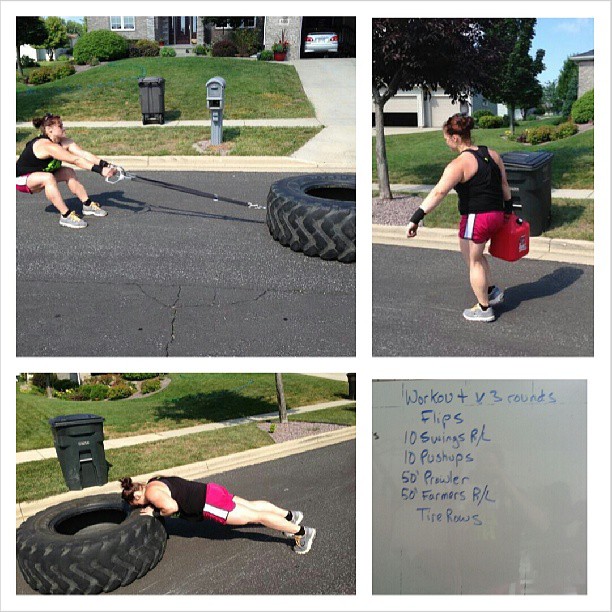
by | Oct 29, 2014 | Building Muscle, Cardio, Fat Loss / Cutting, Motivation, Nutrition
 With the ever-increasing popularity of intense workout programs like CrossFit, metabolic conditioning, or metabolic resistance training (MRT) seems to be a fitness trend that’s here to stay.
With the ever-increasing popularity of intense workout programs like CrossFit, metabolic conditioning, or metabolic resistance training (MRT) seems to be a fitness trend that’s here to stay.
These workouts tend to be intense, impressive, and very cool-looking. Typically, they have the added benefit of giving you a goal to work towards (beat the clock!). Who doesn’t want to flip a big heavy tire, beat things with hammers, and carry around heavy weighted objects as fast as possible?
If you’ve done your part, by the end of the workout, you’re exhausted, sweating from head to toe, and sprawled out on the ground, hoping someone will bring you a protein shake (or maybe a gallon of Ben and Jerry’s…).
Obviously you’ve just had a great strength training workout, right?
Not necessarily.
What is Metabolic Resistance Training?
It can be confusing to understand exactly what this term means since this term is thrown around pretty haphazardly in the fitness world. It is not just a bunch of random exercises done as quickly as possible.
Simply put, Metabolic Resistance Training is a form of metabolic conditioning. The purpose of metabolic conditioning is to increase the efficiency of one of the three pathways used in exercise metabolism. Metabolic conditioning has the added benefit of conditioning the muscles to better use to fuel delivered to them. Ultimately, this should result in a better capacity to burn fat.

I do love pushing vehicles as a supplement to my serious strength training workouts!
Metabolic conditioning can be a great tool if your goal is fat loss. Not only does metabolic conditioning burn tons of calories during a workout, it also increases caloric burn in the 24-48 hours after your workout. This is due to excessive post-exercise oxygen consumption (EPOC). There are various different types of work to rest periods intended to increase EPOC.
A few examples are:
Tabata: 20 seconds of hard work, followed by 10 seconds of rest for 8 total rounds
30 On/30 Off: 30 seconds of hard work, followed by 30 seconds of rest for 6 total rounds
Circuits: Perform 3-6 exercises in a row with minimal to no rest between sets. These exercises should follow a logical pattern and should include elements of pushing, pulling, squatting, hinging, and carrying objects.
Energy Systems – The Goal of MRT
The primary goal of metabolic conditioning is to increase the efficiency of one of three metabolic pathways used in energy metabolism.
Creatine Phosphate Pathway: Also referred to as the Immediate Pathway, this energy system is responsible for providing short (less than 10 seconds) bursts of energy. This is the energy pathway utilized when performing quick power exercises like Olympic or powerlifting-style lifts or sprinting. It takes this energy system about three to five minutes to recover to its fullest potential.
Glycolytic Pathway: Also referred to as the Intermediate Pathway, this energy system provides the energy required for short, intense activities lasting one to four minutes. If you are completing high-intensity cardio intervals or doing multiple reps of a particular exercise, this is the pathway being utilized. It takes this energy system about 1-3 minutes to fully recover.
Aerobic Pathway: Also referred to as the Long-Duration Pathway, this metabolic pathway provides the energy required for longer-duration exercises of moderate-intensity work. This energy system can provide energy for hours of activity, since it has a limitless reserve (fat) to draw upon.
The energy system being conditioned by these workouts is largely determined on the rest period between sets. When structuring a metabolic resistance training circuit, it is important to keep the end goal in mind! The goal is NOT to throw weights around as fast as possible! These workouts should be well structured in order to maximize results.
It is important to remember that regardless of the activity performed, there is always some crossover between energy systems.

Metabolic conditioning is a fun way to get some cardio in, but nothing beats strength!
Is MRT the Same as Strength Training?
MRT typically involves weighted objects such as tires, battle ropes, farmer’s walks, sandbags, and kettlebells. These weighted objects are lifted in rapid succession, and the intensity is kept very high.
However, it is important to remember that the main goal of these workouts is not to maximize strength and to build muscle. The main goal of these workouts is to better utilize energy stored in the body. The primary goal of these workouts is more maintaining strength levels than gaining strength and adding muscle mass.
It’s key to remember that metabolic conditioning is not meant to be a haphazard, random bunch of exercises thrown together with the goal of burning a bazillion calories. These types of workouts are an advanced technique. So advanced in fact, that they are what many elite athletes turn to when they have reached their potential and are simply trying to maintain their current level of fitness. For the average recreational exerciser, it is important to complete these workouts under the supervision of a skilled trainer or strength coach.
The bottom line? You should view MRT workouts as a highly effective form of cardio, along the same lines as HIIT, meant to burn fat. These workouts are not intended to replace conventional strength training.
Is MRT right for you?
MRT can be a fantastic tool in your fat loss arsenal, provided that all other key elements are on pointe.
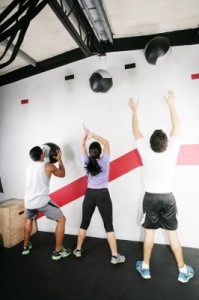 Alwyn Cosgrove, author of the best-selling series New Rules of Lifting, who has a great reputation for results-driven fitness, has come up with a Hierarchy of Fat Loss that can serve as a great checklist to go through when evaluating whether and how new training philosophies will help you reach your goals. You should think about approaching the following elements in order. As long as you are achieving the results you desire, even if progress is slow, there is no reason to add elements further down the list. Stay patient and trust the process!
Alwyn Cosgrove, author of the best-selling series New Rules of Lifting, who has a great reputation for results-driven fitness, has come up with a Hierarchy of Fat Loss that can serve as a great checklist to go through when evaluating whether and how new training philosophies will help you reach your goals. You should think about approaching the following elements in order. As long as you are achieving the results you desire, even if progress is slow, there is no reason to add elements further down the list. Stay patient and trust the process!
1. Nutrition If your ultimate goal is to lose fat and increase lean muscle mass, start with nutrition. Keep it simple, and don’t overthink things. Your first step is to make sure that you are eating enough calories to support a healthy metabolism and maintain your lean muscle mass while you are losing fat. The more muscle you have, the higher your metabolism, so don’t sacrifice your lean mass for a smaller number on the scale! After you have made sure that you are taking in a sufficient amount of calories, look at your protein. A great goal is to take in approximately 1 gram of protein per pound of body weight. Take in plenty of healthy fats, and round everything out with some carbohydrates.
2. Nutrition Yes, it’s that important! Until you get your nutrition on pointe, there’s no point in prioritizing anything else! Activities that burn calories, maintain and promote muscle mass, and elevate metabolism Our metabolism is largely determined by our resting metabolic rate (RMR). RMR largely depends on how much metabolically active tissue (AKA muscle!!!) you have. Therefore, activities that increase RMR by maintaining or gaining muscle mass should be of next importance. A solid, periodized strength training program utilizing heavy weights with well-managed rest periods will accomplish this goal. Your strength training program should include plenty of compound movements like the squat, pull, push, lunge and hinge. Depending on your split, you should be lifting heavy weights 2-4 times per week. Bonus points here if your strength training program uses percentages of 1RM to determine your training loads! Circuit training, high-rep, low weight workouts, and metabolic conditioning do not fall into this category. Some of our favorite recommendations for a solid strength training program include STS, Stronglifts, and New Rules of Lifting for Women.
3. Adding in activities that burn calories and elevate metabolism. This is where activities falling under the realm of metabolic conditioning come in. Metabolic resistance training, HIIT, circuit training, and tabata training are powerful fat loss tools. They are far superior for producing results than traditional, steady-state cardio. If you have your nutrition on pointe, are killing your strength training workouts, and not seeing the results you desire, you may wish to experiment by adding in 1-2 short metabolic conditioning workouts each week. These are meant to supplement, NOT replace your strength training program. These workouts are very taxing and intense, and you may find that by adding them in, your appetite goes soaring through the roof! Make sure that you are continuing to fuel these workouts and getting plenty of recovery time. Adding a short metabolic finisher to the end of your workout might be a better option if you are new to this type of training or are short on time.
4. Activities that burn calories but don’t necessarily maintain muscle or elevate metabolism. If you still have additional time to devote to your training, you might consider adding in a steady-state cardio workout. These workouts will burn calories, but do not put you at any significant metabolic advantage. You should be aware that these types of activities can work against you if your goal is to build or even maintain your current muscle mass. Therefore, steady state cardio should be included as a last resort, only if you are making sure that these activities do not put you in too large of a caloric deficit, and only if you truly enjoy these types of activities.
 Becca is a busy wife and homeschooling mother to five children ages 5 to 13. About three years ago, she embarked on a journey to health and fitness that resulted in the loss of approximately 100 pounds. Today, she is a competitive powerlifter and strongwoman who loves ice cream and deadlifts. As an ISSA certified personal trainer, she is passionate about helping women to get started on a lifestyle of strength and fitness.
Becca is a busy wife and homeschooling mother to five children ages 5 to 13. About three years ago, she embarked on a journey to health and fitness that resulted in the loss of approximately 100 pounds. Today, she is a competitive powerlifter and strongwoman who loves ice cream and deadlifts. As an ISSA certified personal trainer, she is passionate about helping women to get started on a lifestyle of strength and fitness.

by EM2WL | Oct 9, 2014 | Cardio, Fat Loss / Cutting
How to Maximize Gym Time
Let’s face it, life is busy. Whether we’re single, married, have ten kids, have no kids, in school, working, you name it- we’re always racing the clock! Although our schedules are hectic, many of us realize the importance of finding time in our day to squeeze in some exercise. When working with a limited slot of time, we want to find ways to optimize that part of our day so we can be efficient, work hard, and get results. There are certain things that we can do to maximize our gym time and get more bang for our buck.
Have a Plan
 Unless this is your first time ever reading this blog or hearing from me, you know that my biggest pet-peeve (and with good reason!) is to see (or even HEAR) about people wandering aimlessly about life – well, at least the fitness side of it – with no plan. Ack! I mean, unless you are completely new to working out, or testing out gym equipment is your hobby, get a plan – and work that baby. Not only is following some sort of plan best for maximizing gym time, but it’s best for maximizing RESULTS! In other words, if you want to workout with purpose, having a plan is non-negotiable.
Unless this is your first time ever reading this blog or hearing from me, you know that my biggest pet-peeve (and with good reason!) is to see (or even HEAR) about people wandering aimlessly about life – well, at least the fitness side of it – with no plan. Ack! I mean, unless you are completely new to working out, or testing out gym equipment is your hobby, get a plan – and work that baby. Not only is following some sort of plan best for maximizing gym time, but it’s best for maximizing RESULTS! In other words, if you want to workout with purpose, having a plan is non-negotiable.
Random workouts – especially once you move past the newbie gain phase – often equal random results. You may ultimately desire to move to a more intuitive style of workouts, but when time is of the essence and you’re not quite familiar with how certain things fit – just stick to the plan.
Trust me, I’ve been there, and I know how easy it is to get sucked into the “atmosphere” and completely lose 2 hours of your day before feeling like you’ve done enough to warrant leaving. I also know that amount of time is completely unnecessary, and is typically a contributing factor to why many of us will totally scrap our workout if we’re running short on time. If you have a plan (preferably created by a professional, unless you are familiar with periodization and putting together effective workout combos) you have an accurate measure of how “done” you are at any given time increments. Let your trainer know that you are time crunched, or search out specifically, workout plans that fit with your goals and available time slots. Don’t follow some random 6-day, 1hour/day, workout split if you only have time to hit the gym 3 days/wk for 30-45 min, tops.
Have a Plan B
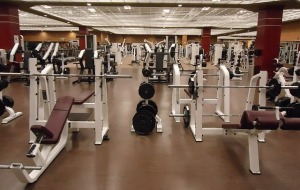
Your gym not this big OR empty? Have a Plan B!
This is where the OCD-plan-follower can relax a bit, and the ADD exerciser can rejoice. Yes, an overall, solid, plan is first and foremost, but remind yourself that it’s OK (and often necessary) to be flexible. Why? Because there will be a time that you get to the gym, totally pumped to hit the squat rack. You’ll head in, struttin your stuff with your Converses and new beasty, striped knee-high socks, and bam – all squat racks taken. Argh! This happens a lot in busier gyms during peak times. Don’t rely on one particular piece of equipment for your exercises. Have an idea of what you want to do, but don’t be married to it.
For instance: If it’s leg day – and you’re scheduled to do squats – you’re good no matter what, because you have a backup plan. Full squat racks aren’t stopping you, it’s off to the hack squat machine or an empty area to do squats with dumbbells. Bench day and no rack available? Head for the Smith machine (add extra weight to make up the bar weight difference), or take a set of dumbbells or even the straight curl bar (many gyms have up to 120 lbs) over to the free weight adjustable bench area.
Now this does NOT mean that you should take a professionally written program and chop it up by doing your own take on EVERY move, but you should know how to if you ever truly needed. Take the time on a less busy/off day to get to know alternate pieces of equipment that can generally get the job done (or ask your trainer if you’re working a plan they’ve given you). Often there are pieces of equipment that look completely different, yet perform similar functions (like the seated vs lying leg curl machines)
Superset
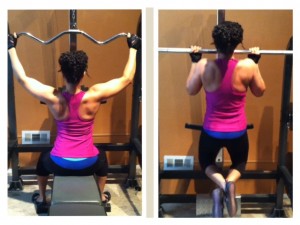
Total Body Supersets Workout Plan
When pressed for time, supersets can be a godsend.
Supersets consist of doing two exercises back to back with no rest in between. You can do exercises for either the same or different muscle groups. For example, you can use the rope attachment on a cable machine and do overhead tricep extensions, one set, and then move the rope down a little and do regular tricep extensions, one set, and repeat. Minimizing time between sets not only does the obvious- saves time- but it really adds a burn to the muscles, as it works muscle fibers differently than normal-set weight training.
Tri-sets (three exercises done back to back), and giant sets (four or more exercises done in a row) also fit into this category. With all supersets, you perform the entire set of two or more exercises, then rest as instructed in your program. If no rest period is indicated, typically 30 seconds is appropriate.
Word of caution for the ladies. Many ladies who are drawn to more endurance style workouts will enjoy supersets because they will feel like they are truly “working” – but I would be cautious of falling into the superset trap of thinking that every thing is better when superset. Sometimes longer rests are called for, and necessary, even in shorter workouts – depending on the phase. So if you are always short on time in the gym, be sure to switch up the types of supersets you do (one month superset the same muscle group, the next month group opposing parts, etc), when the supersets are performed in the workout (on every set one month, on every other set the next, etc), and from time to time put supersets aside altogether for an entire phase or two.
Do High Intensity Interval Training
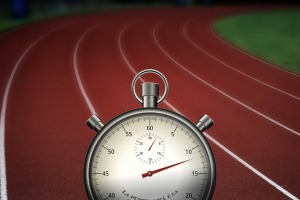 HIIT is praised mostly for two reasons – one, it is a huge time saver and two – the intensity level leads to quicker results than regular cardio and puts your body in a calorie burning state for hours after. Imagine swapping that twenty minute trek on the dreadmill with a quick eight minute sprint session. Suddenly, you’ve gained twelve minutes that you can use to do strength training, ab exercises, stretching, etc. This means that if you were used to splitting up your strength and cardio work to two separate workouts of an hour or so, you can now condense them both into ONE workout that is an hour or less.
HIIT is praised mostly for two reasons – one, it is a huge time saver and two – the intensity level leads to quicker results than regular cardio and puts your body in a calorie burning state for hours after. Imagine swapping that twenty minute trek on the dreadmill with a quick eight minute sprint session. Suddenly, you’ve gained twelve minutes that you can use to do strength training, ab exercises, stretching, etc. This means that if you were used to splitting up your strength and cardio work to two separate workouts of an hour or so, you can now condense them both into ONE workout that is an hour or less.
Try adding true HIIT or Tabata finishers to your strength workouts, rather than dedicating an entire day to each. What do I mean by “true?” Well, because HIIT has become all the rage, we are now bombarded with HIIT workouts popping up left and right ranging anywhere from 10-60 minutes. While they may all be hard in their own right, true HIIT brings the intensity like no other. Intensity meaning that if you can do any interval for longer than 30ish seconds, or any workout lasting longer than 20ish minutes (not including any warmup/cooldown)…it’s not hard enough. You need super intense intervals where you are going at a crazy, all-out (RPE 10+) effort for 20-30 seconds (and absolutely can’t go longer even if you wanted), and then resting for another 20-30 before repeating. This type of training is short and to the point, making it perfect to tack on to the end of you workout.
A couple words of warning with HIIT. 1) It’s not for everyone, allow yourself to work up to it if you’re newer to working out (perhaps with one of the HIIT-like workouts with longer duration or intervals mentioned above). 2) If a 20 minute HIIT workout early in the AM leaves you worn out and more sedentary than usual for the rest of the day – you are negating the benefits of the afterburn. You may want to stick to 30-40 min of a different cardio activity that will still allow you to get in normal amounts of daily activity/productivity every day.
Stay Focused
 Above all, the most important way to maximize your workout is to have laser beam focus. Don’t stress over having to shorten your gym time for a season. Be fully present, engaged in the workout, giving it your all, and knowing that it’s enough. If you head into a workout feeling obligated, and like you just have to get it done to get it out of the way, you won’t be as efficient as possible. If you practice negative self-talk and feel that working out serves as a form of punishment for bad food choices, you’ll have a hard time finding yourself getting in a good sweat (or being satisfied with a less sweaty workout). Remembering why you choose to be active is important, encouraging part of your journey. While physical benefits (toned muscles, smaller waistlines) are a nice perk of working out, living a healthier and happier life far surpass them all.
Above all, the most important way to maximize your workout is to have laser beam focus. Don’t stress over having to shorten your gym time for a season. Be fully present, engaged in the workout, giving it your all, and knowing that it’s enough. If you head into a workout feeling obligated, and like you just have to get it done to get it out of the way, you won’t be as efficient as possible. If you practice negative self-talk and feel that working out serves as a form of punishment for bad food choices, you’ll have a hard time finding yourself getting in a good sweat (or being satisfied with a less sweaty workout). Remembering why you choose to be active is important, encouraging part of your journey. While physical benefits (toned muscles, smaller waistlines) are a nice perk of working out, living a healthier and happier life far surpass them all.
Photo Cred: Danilo Rizzuti

by EM2WL | Jun 5, 2014 | Building Muscle, Cardio, Fat Loss / Cutting, Nutrition
Q: I’ve been lifting for about a year. I love my time at the bar, but I’m frustrated by my lack of progress! I see my training partner’s lifts going up consistently, but I can’t seem to push past plateaus! What am I doing wrong?
A: There are a number of possible explanations why you may have hit a plateau with your lifts. Be aware that almost everyone reaches a point where their lifts have stalled, but usually, when your lifts have stalled it is a good sign to look at your programming and determine if a small tweak or two could help.
It’s also important to remember that those new to lifting will make very quick progress regardless of what program they are following. After a few years of lifting however, it’s important to pay closer attention to the details.
Below are a few of the reasons why your lifting may have stalled.
1. Trying to lose fat (cals/carbs too low)
After you get past the stage of newbie gains, it is very difficult to gain strength while in a caloric deficit. You will probably find that you are able to consistently increase strength, gain muscle and lose fat (albeit very slowly) eating closer to your maintenance level calories. This isn’t to say that it can’t be done, but you will probably want to pay very close attention to nutrient timing, making sure to take in plenty of carbohydrates pre- and post-workout.
When trying to lose fat, many tend to view carbs as “optional.” However, if you are desiring to increase strength, cutting out carbs is not the wisest idea. Carbohydrates are your body’s preferred source of energy for intense workouts. Furthermore, when carbohydrates are adequate in the diet, it spares protein from being used for energy, and protein can do its job-build and repair muscle tissue.
When starting a cut, it’s best to decrease carbohydrates and calories very slowly, keeping an eye on your training and the way that you feel and tweaking things accordingly. If you are consistently feeling very run down and missing lifts in the gym, you may want to consider increasing your carbohydrates and possibly cutting back on the amount of fat that you are taking in.
Generally, slow-acting carbohydrates(sweet potatoes, whole grains, and low-glycemic fruits) are best consumed about 30 minutes to an hour prior to your strength training session. This will provide enough time for digestion so that you don’t go into your workout feeling overstuffed. Fast-acting carbohydrates (white potatoes or rice, foods high in sugar, or high-glycemic fruits) are best taken in during the hour after training.
Following an intense strength training session, your cells are depleted of both glucose and glycogen. Cortisol levels are also elevated. Fast-acting carbohydrates cause an increase in insulin levels, which in turn can cause greater muscle growth, when timed appropriately. When consumed, simple carbohydrates can be stored as glycogen, which is the primary source of muscle “fuel” during intense training sessions.
Post workout, elevated insulin levels allow muscle to better utilize stored glycogen for recovery and growth. This also helps cortisol levels to return to normal levels following an intense training session.
Don’t fear carbs, but learn how to use them to complement your training!
2. Too much emphasis on endurance activities
Another common mistake that strength trainers, especially women, make is of doing too many reps, too much cardio, and too many exercises that fatigue the smaller muscle groups. If your primary goal is to gain strength, you will want to keep your reps low and your weights high (3-5 reps at 80-85%1RM) on compound movements. Always do your compound movements (squat, bench, deadlift, rows, and presses) first, and use assistance work as needed to bring up weak points and provide an environment for hypertrophy. Assistance work should still be kept in the range of 8-12 reps for 3-5 sets. If you are able to do more than 12 reps, it is probably a good idea to increase the weight.
Cardio is a question that tends to come up frequently. A lot of women are okay with incorporating some strength training into their workout rotation, but panic at the thought of cutting back on or eliminating cardio. However, if your primary goal is to increase strength, too many endurance activities (i.e., steady-state cardio) can detract from the strength gains you are wanting to see.
If you still want to include some cardiovascular training into your workout rotation, the best scenario would be to add in some short (4-12 minute) metabolic finishers at the end of your strength training sessions. A metabolic finisher is an intense exercise or circuit of exercises designed to increase your body’s fat-burning potential by increasing the “afterburn effect” by increasing the number of calories burned as you recover from your workout. It speeds recovery by returning blood flow to the muscles and improving all-0ver conditioning and athleticism.
Good options for metabolic finishers include heavy kettlebell swings, tire flips, various forms of weighted carries, barbell complexes, sprints, prowler/sled work, and body weight exercises.
3. It’s all in your head
Sometimes, we are our own worst enemy to making progress. If you’re going for a PR, there should be no question in your mind that you will finish the lift. If you approach PR attempts with a fear of failing or a less than confident approach, chances are you will hinder any forward progress.
When you are going for a PR attempt, you must be completely confident as you approach the bar. Training with good spotters that you trust is crucial as you train with very heavy weights, especially as you go for lifts that are near 100% 1RM. There is a time and place for training to failure, but generally speaking, you will always want to end your training session successfully.
If you have any doubt in your mind that you won’t finish a lift, save it for another day.
4. Under- recovery between sets/training sessions
Another common mistake is failing to recover adequately, either in between sets or in between training sessions. It’s critical that the length of your rest periods lines up with your goals. Since it requires about 3 minutes for phosphagen stores to be replenished, 3 minute rest periods are probably most optimal if you are training for pure strength.
Full recovery will allow you to generate the most muscular power for each set, making each set as effective as possible. If you are training for pure strength, slow down in between sets, sip water, and get mentally refocused before beginning your next set.
Make sure that you are taking adequate time between training sessions to recover as well. A good rule of thumb is to take about 48 hours recovery in between intense training sessions. However, you can train opposing body parts on consecutive days (upper body on Monday, lower body Tuesday, rest Wednesday, upper body Thursday, lower body Friday). Make sure that your rest days are truly restful.
In addition, you will want to make sure that you are taking in plenty of high quality food, sleeping well, and keeping stress levels as low as possible to maximize your recovery time!
5. Attempting too much, too soon
It’s important to make sure that the strength goals that you have outlined for yourself are reasonable. Attempting to increase too much weight too soon will most likely result in injury, frustration, and breakdown in form.
Choose a solid, periodized program and determine to stick with it and trust the process! Training with sub-maximal weights will get you stronger over time. On a similar note, testing training maxes too often is extremely taxing on your CNS and will make recovery in between training sessions much more difficult. Focus instead on setting rep PRs, and leave training maxes to once every 4 weeks, at most.
Generally speaking, a reasonable expectation would be to see lower body lifts increase by about 10-20 pounds and upper body lifts increase by about 5-10 pounds over a 8-12 week period of time, provided you are being consistent in your training and paying attention to your nutrition. It may not seem like much, but over time, you will be amazed at your progress if you can learn to be patient with small strength gains.
6. Same old, same old
Our bodies are very good at making adaptations to the stressors that we place upon it. In order to continue to make progress, it is important to switch things up every once in awhile.
If you’re stuck at a strength plateau and have been following the same program or rep scheme for over 12 weeks, it is probably a good idea to switch things up. If you’re used to training in the 8-12 rep range, you may switch to a 5 x 5 for awhile and work on increasing your weights. If you’ve been training with heavy weights and low reps for awhile, you may benefit from an increase in volume. Varying your assistance work is an other great way to keep your body challenged!
However, a word of caution: make sure to change one or two things at a time and stick it out for a minimum of 8-12 weeks before changing another factor. It’s very important to make small changes and make careful notes about what is working. If you change too many things at once, you will never know what’s working!
7. Bad technique
Take the time to learn proper form, especially on the three big lifts (bench, squat, and deadlift). Always train to a full range of motion, and you will get the maximum benefit from each rep and set. If you are unsure about proper form on these lifts, you might benefit greatly from setting up an appointment to meet with a personal trainer, or watching instructional videos on Youtube. Start with the empty bar and be patient with yourself. Once you learn proper technique, it will become easier and easier to add weight to that bar and see the strength gains you desire!
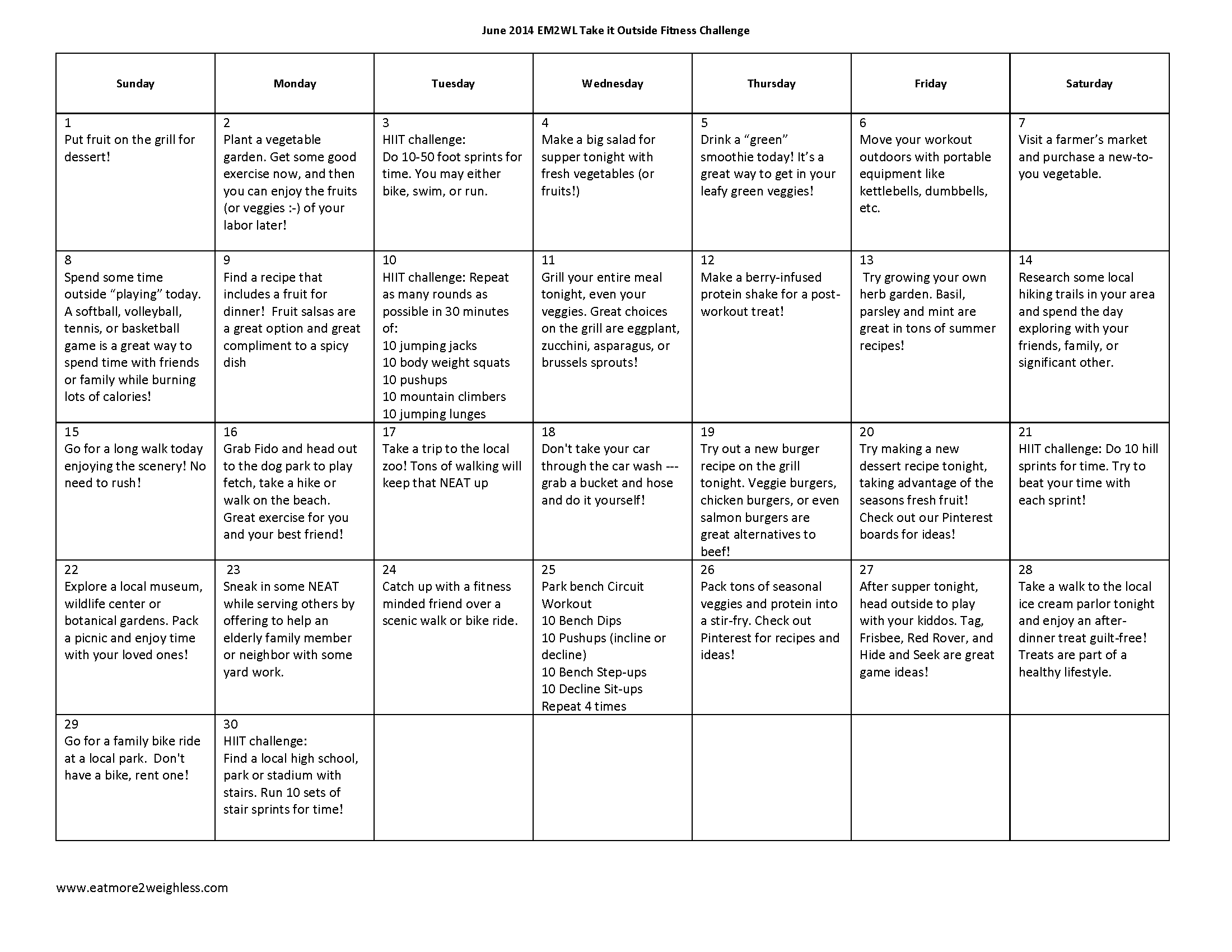
by | May 31, 2014 | Cardio, Life Application: Monthly Calendars, Nutrition

Welcome to Spring! After this extra long Wisconsin winter that I was sure would never end, I know I sure am glad to see the sun here to stay. One of my favorite parts of Spring is the flexibility to take some of my workouts outside. Some of my favorite things that I associate with Spring/Summer: coming home from the local farmer’s market with bags overflowing with fresh, local produce, flipping heavy tires, farmers walks, hill sprints with my kids at the park and baseball games.
Getting in some extra sunshine most definitely lifts my spirits. There’s much to be said about the numerous benefits of getting in some sunshine!

Our challenge this month encourages you to take some of your workouts outdoors. Many of our challenges are meant to be done as a kind of mini-burst to kick up your metabolism and can most definitely replace your cardio! If you have kids, you might bring them to the park and sneak in a quick workout while they are busy on the jungle gym.
We’ve included a few ideas but feel free to make this your own. If one type of activity isn’t your thing, feel free to substitute and make it work for you!

Pretty much the perfect outdoor workout, if you ask me…but to each their own!
We’ve also added some food challenges to encourage you to take advantage of all the great, yummy fresh fruits and vegetables available to you at this time of year. Whenever possible, support your local farmers and community by buying local. You will be amazed at the difference!

We’d love to hear how you rock out this month’s challenge! Do you have a favorite Spring/Summer recipe to share? Send them to success@em2wl.com and we may just feature your recipe on the site!

 Becca is a busy wife and homeschooling mother to five children ages 5 to 13. About three years ago, she embarked on a journey to health and fitness that resulted in the loss of approximately 100 pounds. Today, she is a competitive powerlifter and strongwoman who loves ice cream and deadlifts. As an ISSA certified personal trainer, she is passionate about helping women to get started on a lifestyle of strength and fitness.
Becca is a busy wife and homeschooling mother to five children ages 5 to 13. About three years ago, she embarked on a journey to health and fitness that resulted in the loss of approximately 100 pounds. Today, she is a competitive powerlifter and strongwoman who loves ice cream and deadlifts. As an ISSA certified personal trainer, she is passionate about helping women to get started on a lifestyle of strength and fitness.
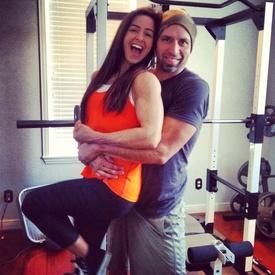
by | Apr 15, 2014 | Building Muscle, Cardio, Consistency, Fat Loss / Cutting, Transformations
 If someone would have told me 20 years ago that I needed to increase my caloric intake by 30% to lose body fat, I would have laughed while continuing to lace up my Mizuno running shoes preparing for my hour long run. Now 5 kids later, a little older and a little wiser, with decades of trial and error underneath my belt, eating more to weigh less has been a key factor in my fitness journey.
If someone would have told me 20 years ago that I needed to increase my caloric intake by 30% to lose body fat, I would have laughed while continuing to lace up my Mizuno running shoes preparing for my hour long run. Now 5 kids later, a little older and a little wiser, with decades of trial and error underneath my belt, eating more to weigh less has been a key factor in my fitness journey.
A common misconception among those that want to lose weight is that you need to drastically cut calories and increase cardio workouts. This problematic approach has resulted in many trying to lose weight to only damage their metabolism. I speak on this issue not only from reading other stories, but I have personally experienced this metabolic damage which resulted in a serious health issue called Adrenal Fatigue. After everything I have learned, when I log onto My Fitness Pal and I see I see others eating 1200 calories with high calorie burns, my instincts are to immediately say, “Stop! Don’t do what I did.” As a longtime “My fitness pal” member, I recall an honest pal, Becca, specifically sharing this very concern with me that I was exercising too much, and not eating enough calories. Initially, for many weeks, I held onto the fallacy that I would attain my dream body while continuing on this path of destruction.
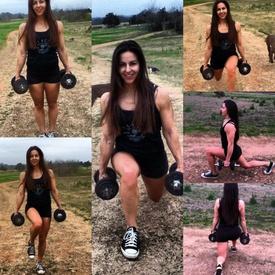 It was not until “my plan” to reach my “goal weight” by my 38th birthday came to a halt when my body reached homeostasis. I had reached a plateau in my weight loss journey and I was no longer losing fat, or gaining muscle. I was starving, exhausted and my body was at a complete standstill. Exasperated and feeling defeated, I went back to the drawing board to research fat loss remembering all the while Becca’s encouragement to eat more. Becca introduced me to a website for calculating calories. After spending some time on this website, I was shocked at the advice given. Based on my height, weight and activity level, I needed to be consuming 30% more calories. This line of thinking was so shocking and it went against every principle “I thought” I knew about losing weight.
It was not until “my plan” to reach my “goal weight” by my 38th birthday came to a halt when my body reached homeostasis. I had reached a plateau in my weight loss journey and I was no longer losing fat, or gaining muscle. I was starving, exhausted and my body was at a complete standstill. Exasperated and feeling defeated, I went back to the drawing board to research fat loss remembering all the while Becca’s encouragement to eat more. Becca introduced me to a website for calculating calories. After spending some time on this website, I was shocked at the advice given. Based on my height, weight and activity level, I needed to be consuming 30% more calories. This line of thinking was so shocking and it went against every principle “I thought” I knew about losing weight.
I even approached my husband with my concerns asking his advice. With the research I had been doing, along with the advice given by Becca and Kiki, it was evident a metabolic reset was necessary. In terror, just 3 weeks away from attempting to reach my birthday goal, I began reverse dieting adding 50-100 calories weekly to reach my Total Daily Energy Expenditure (TDEE). At this time I also implemented a plan to strategically count my macros. I pay close attention to the number of grams of proteins, carbs and fats I intake daily. From my research, the keys to cutting body fat are increasing calories while counting macros, reducing cardio, and increasing my weight lifting.
Well, my 38th birthday came and went. The scale never reached the number in my head, but my goal had changed during this time. I was determined to be fit and healthy versus being skinny. I continued on the metabolism reset with correct macros and increased calories while simultaneously reducing my cardio, and lifting heavy weights.
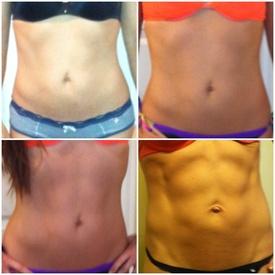 The number on the scale temporarily went up, but then my weight leveled out. One of the first physical changes I observed was my lack of hunger, increased energy level as well as the change in my body composition. My cellulite and fat began to diminish and I could see I was building muscle to form shape to my body. These major changes finally allowed me to feel more comfortable with my body.
The number on the scale temporarily went up, but then my weight leveled out. One of the first physical changes I observed was my lack of hunger, increased energy level as well as the change in my body composition. My cellulite and fat began to diminish and I could see I was building muscle to form shape to my body. These major changes finally allowed me to feel more comfortable with my body.
Although, I agree with counting your macros daily food intake, I am not a fan of “If It Fits Your Macros” simply because many will eat pop tarts, snickers bars, and a bag of chips, if it fits their macros. Although, I do have a weekly cheat, I attempt to eat real whole foods. Food is fuel. As a general rule, I stay away from processed foods, which means making time for prepping meals. With a large family to take care of and working 30+ hours weekly planning meal prep time is just as important as planning my workouts.
I am a homeschooling mother of 5, and I hold a 30+ hour job outside of the home. I make time for heavy lifting 5 days a week along with meal planning. This is not a New Year’s Resolution. This is mine and my husband’s lifestyle. My continued love for fitness has propelled my desire to become a certified personal trainer to continue to learn about fitness while helping others achieve their fitness goals.
Don’t give up on your fitness goals. I believe that anyone who truly wants to be fit and healthy will make the time. There is no secret pill or supplement. Hard work and dedication will help you get to your desired level of fitness. I know the proposition of adding calories for weight loss seems improbable, but I am living proof that it works.
If you are inspired by Tracy’s amazing story, make sure to follow her on Instagram!
 Becca is a busy wife and homeschooling mother to five children ages 5 to 13. About three years ago, she embarked on a journey to health and fitness that resulted in the loss of approximately 100 pounds. Today, she is a competitive powerlifter and strongwoman who loves ice cream and deadlifts. As an ISSA certified personal trainer, she is passionate about helping women to get started on a lifestyle of strength and fitness.
Becca is a busy wife and homeschooling mother to five children ages 5 to 13. About three years ago, she embarked on a journey to health and fitness that resulted in the loss of approximately 100 pounds. Today, she is a competitive powerlifter and strongwoman who loves ice cream and deadlifts. As an ISSA certified personal trainer, she is passionate about helping women to get started on a lifestyle of strength and fitness.
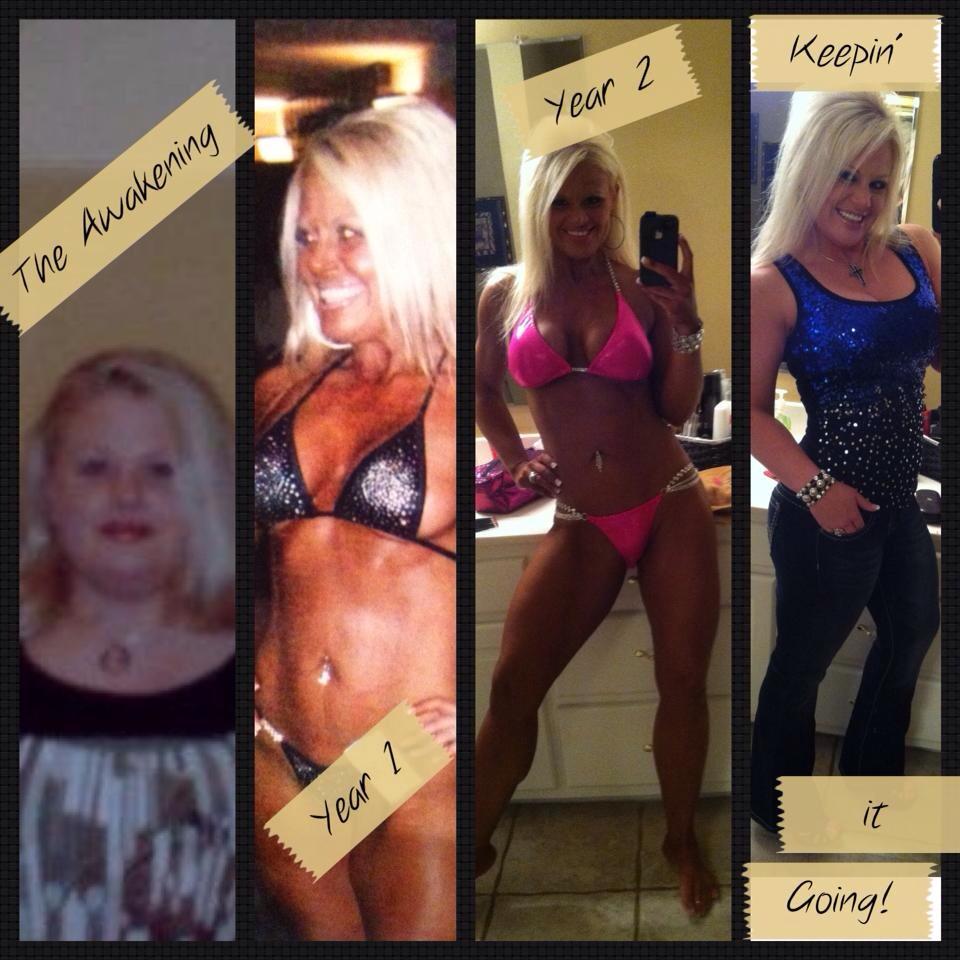
by Trish Adams | Feb 28, 2014 | Cardio, Former Fitness Competitors, Interviews/Guest Posts, Testimonials
After working with a personal trainer for 2 years and competing in her first competition, Stephanie realized that under-eating and doing excessive cardio may not have been the best advice. Now she has put competing on hold to focus on building healthy habits. 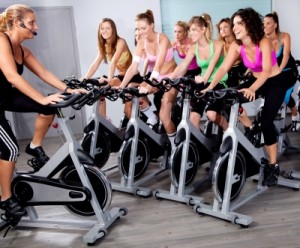 Five years ago I was going through many things in my life that most of my closest friends and family weren’t even aware of. I was depressed and had blown up to 220 pounds. I hated exercise and loved food (still love food). I was embarrassed to even leave my house in fear I would run into someone I knew. A friend asked me to start walking with her. “Ugh!! Really??”..was likely my response. She continued to nag me until I finally gave in. We started walking the track a few times a week. Just a mile. Felt pretty good though. I decided that I hated the way I looked and felt and I was the only person that could fix it. So I started watching my portions and started exercising at home for 20 minutes 6 times a week. Then my friend asked me to do a bootcamp with her. “Ugh!!!!” Yep, again. After assuring me it was suitable for all fitness levels (it wasn’t….at all) I again gave in and went. Longest, hardest and most miserable 60 minutes of my life. But I did it and continued to do it for several weeks a few nights a week until the camp was over. After losing 30 pounds on my own, I was introduced to a personal trainer. I asked his price and hired him on the spot. This was a huge turning point. I trained 3 times a week and took spin 3 times a week. My trainer mentioned the possibility of me competing in fitness competitions. It sounded very intriguing and what a goal!!!! I trained with my trainer 3 times a week for 2 years. In that time I did compete in my first fitness competition. It was probably the most rewarding thing I’ve ever done…and the most physically, mentally and emotionally wrecking.
Five years ago I was going through many things in my life that most of my closest friends and family weren’t even aware of. I was depressed and had blown up to 220 pounds. I hated exercise and loved food (still love food). I was embarrassed to even leave my house in fear I would run into someone I knew. A friend asked me to start walking with her. “Ugh!! Really??”..was likely my response. She continued to nag me until I finally gave in. We started walking the track a few times a week. Just a mile. Felt pretty good though. I decided that I hated the way I looked and felt and I was the only person that could fix it. So I started watching my portions and started exercising at home for 20 minutes 6 times a week. Then my friend asked me to do a bootcamp with her. “Ugh!!!!” Yep, again. After assuring me it was suitable for all fitness levels (it wasn’t….at all) I again gave in and went. Longest, hardest and most miserable 60 minutes of my life. But I did it and continued to do it for several weeks a few nights a week until the camp was over. After losing 30 pounds on my own, I was introduced to a personal trainer. I asked his price and hired him on the spot. This was a huge turning point. I trained 3 times a week and took spin 3 times a week. My trainer mentioned the possibility of me competing in fitness competitions. It sounded very intriguing and what a goal!!!! I trained with my trainer 3 times a week for 2 years. In that time I did compete in my first fitness competition. It was probably the most rewarding thing I’ve ever done…and the most physically, mentally and emotionally wrecking.
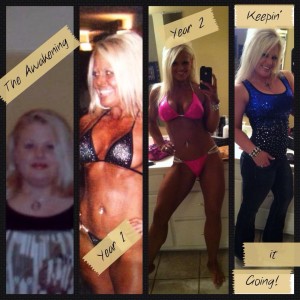
Stephanie’s Transformation
After two years I felt I was outgrowing my trainer and wanted to go in a different direction. I felt the next natural step for me was to become certified to train (I was already a certified spin instructor by this time). I became certified and continued to compete…learning from my mistakes and really bad advice all along the way. Under-eating and over-doing cardio. This year I really changed my approach and decided to skip competing this season. I was developing healthier habits and was afraid my habits were so new that if I competed I would resort back to old ways. Will I compete again? Yes. Hopefully with a much more wise approach. Until then I will continue to search for my happy place while motivating and training others while helping them avoid the pitfalls I suffered. Exercise is the easy part…food…that’s tough. I have to remember to give myself credit (and a break) for how far I have come…even though I still have so far to go to become balanced.
Has eating more changed your life? Have an EM2WL transformation to share? We’d love to see it! Be featured on our Transformation/Journey page by submitting your story to Success@EM2WL.com
Spin photo credit: Photostock

 With the ever-increasing popularity of intense workout programs like CrossFit, metabolic conditioning, or metabolic resistance training (MRT) seems to be a fitness trend that’s here to stay.
With the ever-increasing popularity of intense workout programs like CrossFit, metabolic conditioning, or metabolic resistance training (MRT) seems to be a fitness trend that’s here to stay. Alwyn Cosgrove, author of the best-selling series New Rules of Lifting, who has a great reputation for results-driven fitness, has come up with a Hierarchy of Fat Loss that can serve as a great checklist to go through when evaluating whether and how new training philosophies will help you reach your goals. You should think about approaching the following elements in order. As long as you are achieving the results you desire, even if progress is slow, there is no reason to add elements further down the list. Stay patient and trust the process!
Alwyn Cosgrove, author of the best-selling series New Rules of Lifting, who has a great reputation for results-driven fitness, has come up with a Hierarchy of Fat Loss that can serve as a great checklist to go through when evaluating whether and how new training philosophies will help you reach your goals. You should think about approaching the following elements in order. As long as you are achieving the results you desire, even if progress is slow, there is no reason to add elements further down the list. Stay patient and trust the process! Becca is a busy wife and homeschooling mother to five children ages 5 to 13. About three years ago, she embarked on a journey to health and fitness that resulted in the loss of approximately 100 pounds. Today, she is a competitive powerlifter and strongwoman who loves ice cream and deadlifts. As an ISSA certified personal trainer, she is passionate about helping women to get started on a lifestyle of strength and fitness.
Becca is a busy wife and homeschooling mother to five children ages 5 to 13. About three years ago, she embarked on a journey to health and fitness that resulted in the loss of approximately 100 pounds. Today, she is a competitive powerlifter and strongwoman who loves ice cream and deadlifts. As an ISSA certified personal trainer, she is passionate about helping women to get started on a lifestyle of strength and fitness.








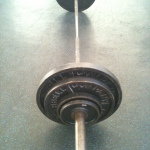














Recent Comments